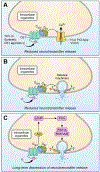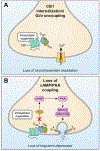Synaptic changes induced by cannabinoid drugs and cannabis use disorder
- PMID: 35219856
- PMCID: PMC12217231
- DOI: 10.1016/j.nbd.2022.105670
Synaptic changes induced by cannabinoid drugs and cannabis use disorder
Abstract
The legalization of cannabis in many countries, as well as the decrease in perceived risks of cannabis, have contributed to the increase in cannabis use medicinally and recreationally. Like many drugs of abuse, cannabis and cannabis-derived drugs are prone to misuse, and long-term usage can lead to drug tolerance and the development of Cannabis Use Disorder (CUD). These drugs signal through cannabinoid receptors, which are expressed in brain regions involved in the neural processing of reward, habit formation, and cognition. Despite the widespread use of cannabis and cannabinoids as therapeutic agents, little is known about the neurobiological mechanisms associated with CUD and cannabinoid drug use. In this article, we discuss the advances in research spanning animal models to humans on cannabis and synthetic cannabinoid actions on synaptic transmission, highlighting the neurobiological mechanisms following acute and chronic drug exposure. This article also highlights the need for more research elucidating the neurobiological mechanisms associated with CUD and cannabinoid drug use.
Keywords: Cannabinoid 1 receptor; Cannabis sativa; Delta-9 tetrahydrocannabinol; Endocannabinoid; Long-term depression; Long-term potentiation; Synaptic Modulation.
Published by Elsevier Inc.
Conflict of interest statement
Declaration of Competing Interest
None.
Figures


Similar articles
-
Cannabis and cannabinoids for symptomatic treatment for people with multiple sclerosis.Cochrane Database Syst Rev. 2022 May 5;5(5):CD013444. doi: 10.1002/14651858.CD013444.pub2. Cochrane Database Syst Rev. 2022. PMID: 35510826 Free PMC article.
-
Advances in cannabinoid receptors pharmacology: from receptor structural insights to ligand discovery.Acta Pharmacol Sin. 2025 Jun;46(6):1495-1510. doi: 10.1038/s41401-024-01472-9. Epub 2025 Feb 5. Acta Pharmacol Sin. 2025. PMID: 39910211 Review.
-
A Systematic Review of the Efficacy of Cannabinoid Agonist Replacement Therapy for Cannabis Withdrawal Symptoms.CNS Drugs. 2018 Dec;32(12):1113-1129. doi: 10.1007/s40263-018-0577-6. CNS Drugs. 2018. PMID: 30361897
-
Cannabinoid content on product labels influences cannabis health perceptions.Ann Behav Med. 2025 Jan 4;59(1):kaaf046. doi: 10.1093/abm/kaaf046. Ann Behav Med. 2025. PMID: 40553093
-
Exploring Novel Pharmacotherapy Candidates for Cannabis Use Disorder: Uncovering Promising Agents on the Horizon by Mechanism of Action.Drugs. 2024 Nov;84(11):1395-1417. doi: 10.1007/s40265-024-02098-1. Epub 2024 Oct 10. Drugs. 2024. PMID: 39388076 Free PMC article. Review.
Cited by
-
The impact of phyto- and endo-cannabinoids on central nervous system diseases:A review.J Tradit Complement Med. 2022 Oct 12;13(1):30-38. doi: 10.1016/j.jtcme.2022.10.004. eCollection 2023 Jan. J Tradit Complement Med. 2022. PMID: 36685079 Free PMC article. Review.
-
Striatonigral direct pathway 2-arachidonoylglycerol contributes to ethanol effects on synaptic transmission and behavior.Neuropsychopharmacology. 2023 Dec;48(13):1941-1951. doi: 10.1038/s41386-023-01671-8. Epub 2023 Aug 1. Neuropsychopharmacology. 2023. PMID: 37528221 Free PMC article.
-
Cognitive Alterations in Addictive Disorders: A Translational Approach.Biomedicines. 2023 Jun 23;11(7):1796. doi: 10.3390/biomedicines11071796. Biomedicines. 2023. PMID: 37509436 Free PMC article. Review.
-
Monoacylglycerol Lipase Modulators for Treating Autism Spectrum Disorders.ACS Med Chem Lett. 2023 Apr 14;14(5):545-546. doi: 10.1021/acsmedchemlett.3c00121. eCollection 2023 May 11. ACS Med Chem Lett. 2023. PMID: 37197472 Free PMC article.
-
Early endocannabinoid-mediated depolarization-induced suppression of excitation delays the appearance of the epileptic phenotype in synapsin II knockout mice.Cell Mol Life Sci. 2024 Jan 12;81(1):37. doi: 10.1007/s00018-023-05029-7. Cell Mol Life Sci. 2024. PMID: 38214769 Free PMC article.
References
-
- Aceto MD, et al. , 1998. Anandamide, an endogenous cannabinoid, has a very low physical dependence potential. J. Pharmacol. Exp. Ther 287, 598–605. - PubMed
-
- Adams R, 1940. Marihuana. Science 92, 115–119. - PubMed
-
- Ahrens J, et al. , 2009. The nonpsychotropic cannabinoid cannabidiol modulates and directly activates alpha-1 and alpha-1-Beta glycine receptor function. Pharmacology 83, 217–222. - PubMed
Publication types
MeSH terms
Substances
Grants and funding
LinkOut - more resources
Full Text Sources
Medical

